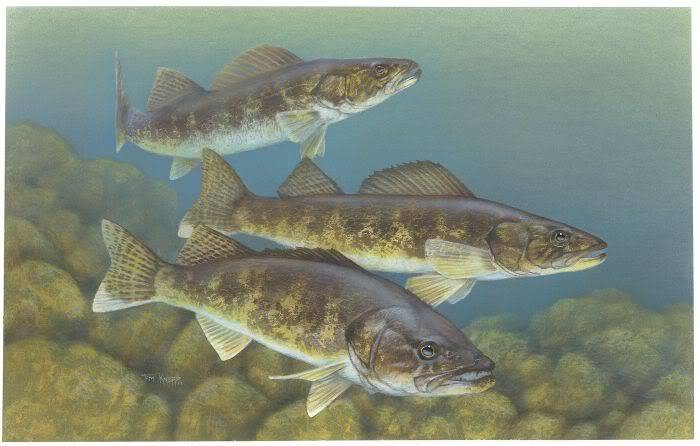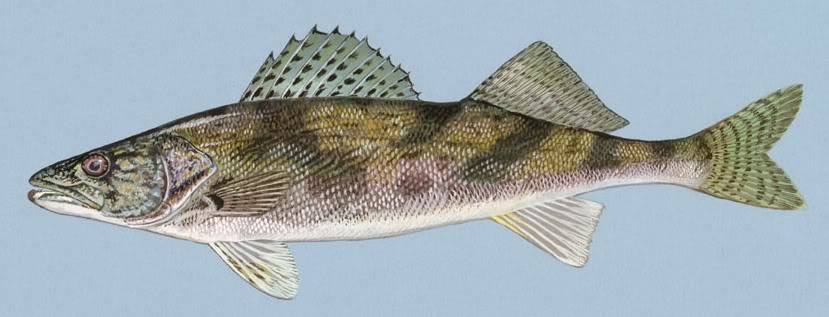saltfisher1
Half-Dollar


Number of posts : 8362
Age : 52
Location : Alabama/Florida Gulf coast
Registration date : 2008-02-05
 |  Subject: Walleye/Sauger Identification Subject: Walleye/Sauger Identification  Thu Feb 26, 2009 8:59 am Thu Feb 26, 2009 8:59 am | |
| Walleye Meaning of the name The common name, "walleye," comes from the fact that their eyes, like those of cats, reflect light. This eyeshine is the result of a light-gathering layer in the eyes called the tapetum lucidum which allows the fish to see well in low-light conditions. In fact, many anglers look for walleyes at night since this is when most major feeding patterns occur. Their eyes also allow them to see well in turbid waters (stained or rough, breaking waters) which gives them an advantage over their prey. Thus, walleye anglers will commonly look for days and locations where there is a good "walleye chop" (i.e., rough water). This excellent vision also allows the fish to populate the deeper regions in a lake and can often be found in deeper water. This also means that since they live and spawn in mostly shallow waters, they can see onto or near the shore for disturbances in the water such as humans. Physical Description Walleyes grow to about 75 cm (30 in) in length, and weigh up to about 7 kg (15 lb). The maximum recorded size for the fish is 107 cm (42 in) in length and 11.3 kg (25 lb) in weight. The growth rate depends partly on where in their range they occur, with southern populations often growing faster and larger. In general, females grow larger than males. Walleyes may live for decades; the maximum recorded age is 29 years. In heavily fished populations, however, few walleye older than 5 or 6 years of age are encountered. In North America, where they are heavily prized, their typical size when caught is on the order of 18-25 inches, substantially below their potential size. Walleyes are largely olive and gold in colour (hence the French common name: doré—golden). The dorsal side of a walleye is olive, grading into a golden hue on the flanks. The olive/gold pattern is broken up by five darker saddles that extend to the upper sides. The colour shades to white on the belly. The mouth of a walleye is large and is armed with many sharp teeth. The first dorsal and anal fins are spinous as is the operculum. Walleyes are distinguished from their close cousin the sauger by the white colouration on the lower lobe of the caudal fin which is absent on the sauger. In addition, the two dorsals and the caudal fin of the sauger are marked with distinctive rows of black dots which are absent from or indistinct on the same fins of walleyes. 
Last edited by saltfisher1 on Thu Feb 26, 2009 4:26 pm; edited 2 times in total | |
|
saltfisher1
Half-Dollar


Number of posts : 8362
Age : 52
Location : Alabama/Florida Gulf coast
Registration date : 2008-02-05
 |  Subject: Re: Walleye/Sauger Identification Subject: Re: Walleye/Sauger Identification  Thu Feb 26, 2009 9:00 am Thu Feb 26, 2009 9:00 am | |
| Sauger The sauger (Sander canadensis) is a freshwater perciform fish of the family Percidae which resembles its close relative the walleye. Saugers, however, are usually smaller and will tolerate waters of higher turbidity than will the walleye. In many parts of their range, saugers are sympatric with walleyes. They may be distinguished from walleyes by the distinctly spotted dorsal fin, by the lack of a white splotch on the caudal fin, by the rough skin over their gill, and by their generally more brassy color, or darker (almost black) color in some regions. The average sauger in an angler's creel is 300 to 400 g (0.75 to 1 lbs) in weight but the world record was 8.1 kg (17 lbs, 12 ounces.) Saugers are more typical of rivers whereas walleyes are more common in lakes and reservoirs. The sauger is highly prized as a food fish. Hybridization between saugers and walleyes is not unknown; the hybrids, referred to as saugeyes, exhibit traits of both species. Being intermediate in appearance between the two species, saugeyes are sometimes difficult to differentiate, but they generally carry the dark blotches characteristic of the sauger.  | |
|
North Star
Site owner


Number of posts : 12875
Age : 60
Location : Minnesota
Registration date : 2007-12-05
 |  Subject: Re: Walleye/Sauger Identification Subject: Re: Walleye/Sauger Identification  Thu Feb 26, 2009 9:31 am Thu Feb 26, 2009 9:31 am | |
| Looks Good Buddy It Does It Does Wish I Had Them In A Frying Pan.  | |
|
Sponsored content
 |  Subject: Re: Walleye/Sauger Identification Subject: Re: Walleye/Sauger Identification  | |
| |
|
